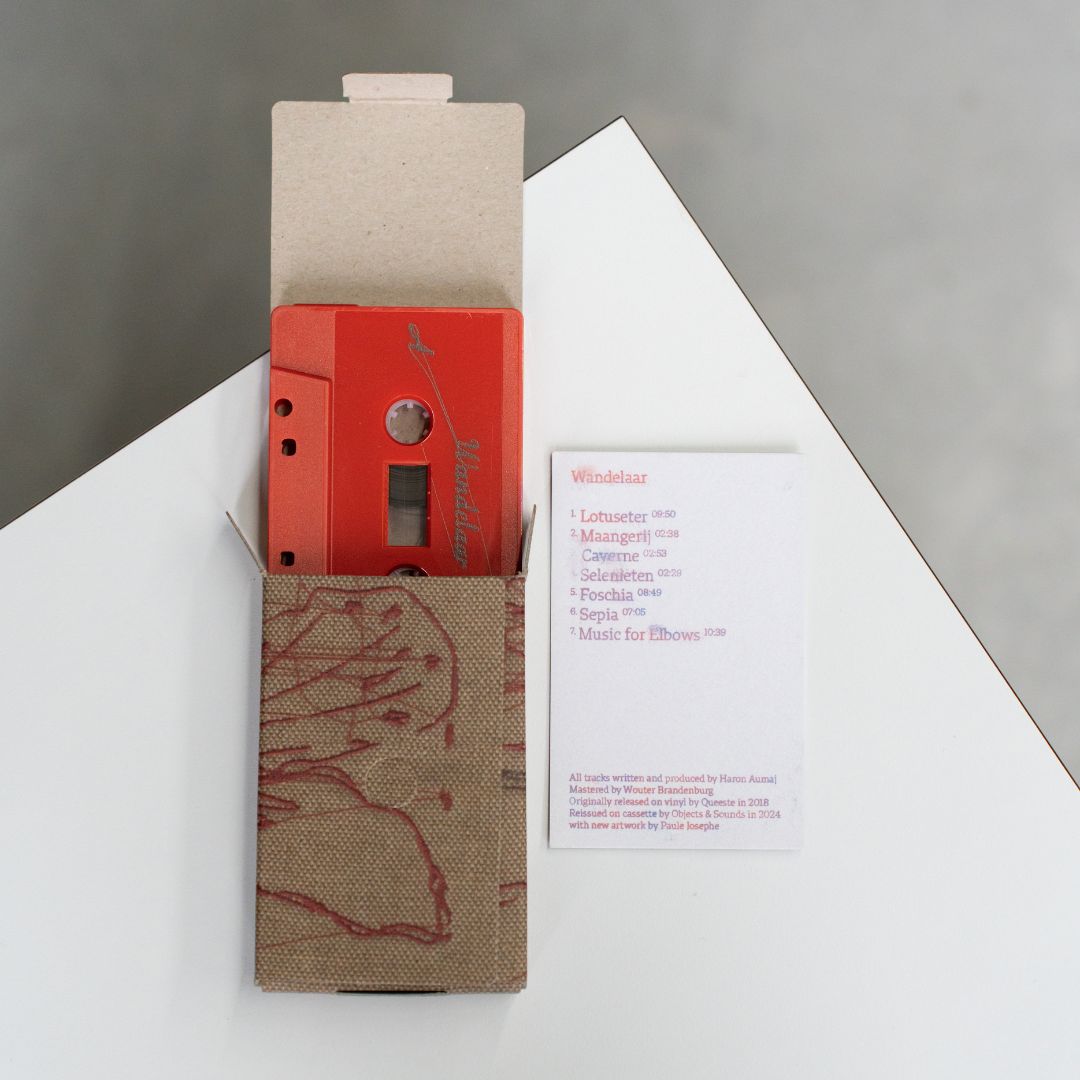no products in the cart
0

A record that has stayed with us through the years, Haron’s Wandelaar is reimagined in this cassette reissue with new artwork by our friends at Paule Josephe. Drawing inspiration from hypersensitive wax moths—creatures attuned to the subtlest shifts in their surroundings—this release extends into a five-piece series of all-gender shirts, crafted from secondhand garments and thoughtfully reworked with delicate embroidered details.
The delicate use of space and sparse piano feels less like a pronounced choice and more like a direct reflection of Haron’s inner world—the balance between meandering thoughts and quiet stillness. As if floating on an opalescent sea, a lone traveler beneath a moonlit sky, it’s a quiet, sacred passage that the sojourner must follow—a journey into their own heart.
Haron’s Wandelaar is an album that successfully transforms listening into an act of transport, leaving you on the cusp of sleep, at a junction of dislocation, hazily arriving in a liminal world. It represents Haron’s reaction against the confines of dance music, channeling energy from his estrangement from its limitations and expectations, and using it as a means to reorder and interrogate sound.
In Wandelaar, Haron employs the piano to cascade listeners into a suspended state of consciousness, exploring his enduring interest in music’s ability to induce and influence dreams. As we listen, we follow the album’s narrative arc of ascension, envisioning a "moony landscape," grey and desolate from afar, yet intricately detailed upon closer inspection—a reflection of the minimal canon of its composition. The album conjures imagery of vast drifting spheres, cavernous spaces, reflective surfaces, crystals, and endless lights.
The opening track, Lotuseter, is a sparse, pensive arrangement that feels inquisitive, almost timid, as Haron tentatively makes his first contact. This evolves seamlessly into more movement and vitality with Maangerij and the shimmering, rattling textures of Caverne. In Selenieten, soft thuds and a clunky arpeggio set a meditative tone, while in Foschia, we arrive at a more melodic scene, where the pace nimbly shifts before culminating in one of the album’s most cinematic moments. The harmonic chords of Sepia rest gently in a lullaby-like attunement, leading into the album’s closing and most whimsical piece, Music for Elbows, a sketched arrangement absent of rigid design, playfully composed.
Wandelaar is, above all, a visual album—one that challenges not only the strictures of composition but also the listener’s senses. Centering on the modest piano, each solo note becomes fertile and full, suspended and deliberate. The notes engage in a conversation, granting each other the space to breathe and resonate.
€14,00
in stock

A record that has stayed with us through the years, Haron’s Wandelaar is reimagined in this cassette reissue with new artwork by our friends at Paule Josephe. Drawing inspiration from hypersensitive wax moths—creatures attuned to the subtlest shifts in their surroundings—this release extends into a five-piece series of all-gender shirts, crafted from secondhand garments and thoughtfully reworked with delicate embroidered details.
The delicate use of space and sparse piano feels less like a pronounced choice and more like a direct reflection of Haron’s inner world—the balance between meandering thoughts and quiet stillness. As if floating on an opalescent sea, a lone traveler beneath a moonlit sky, it’s a quiet, sacred passage that the sojourner must follow—a journey into their own heart.
Haron’s Wandelaar is an album that successfully transforms listening into an act of transport, leaving you on the cusp of sleep, at a junction of dislocation, hazily arriving in a liminal world. It represents Haron’s reaction against the confines of dance music, channeling energy from his estrangement from its limitations and expectations, and using it as a means to reorder and interrogate sound.
In Wandelaar, Haron employs the piano to cascade listeners into a suspended state of consciousness, exploring his enduring interest in music’s ability to induce and influence dreams. As we listen, we follow the album’s narrative arc of ascension, envisioning a "moony landscape," grey and desolate from afar, yet intricately detailed upon closer inspection—a reflection of the minimal canon of its composition. The album conjures imagery of vast drifting spheres, cavernous spaces, reflective surfaces, crystals, and endless lights.
The opening track, Lotuseter, is a sparse, pensive arrangement that feels inquisitive, almost timid, as Haron tentatively makes his first contact. This evolves seamlessly into more movement and vitality with Maangerij and the shimmering, rattling textures of Caverne. In Selenieten, soft thuds and a clunky arpeggio set a meditative tone, while in Foschia, we arrive at a more melodic scene, where the pace nimbly shifts before culminating in one of the album’s most cinematic moments. The harmonic chords of Sepia rest gently in a lullaby-like attunement, leading into the album’s closing and most whimsical piece, Music for Elbows, a sketched arrangement absent of rigid design, playfully composed.
Wandelaar is, above all, a visual album—one that challenges not only the strictures of composition but also the listener’s senses. Centering on the modest piano, each solo note becomes fertile and full, suspended and deliberate. The notes engage in a conversation, granting each other the space to breathe and resonate.


sign up for moody picks, inspiring interviews & more.

